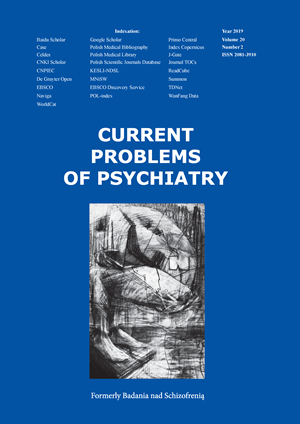Dissociative identity disorder as a wide range of defense mechanisms in children with a history of early childhood trauma
DOI:
https://doi.org/10.2478/cpp-2019-0006Keywords:
dissociative identity disorder, multiple personality, defense mechanismsAbstract
Introduction: Dissociative identity disorder, also known as multiple personality disorder, involves simultaneous manifestation of multiple alternative personalities in one human body. The disorder is still a puzzle to contemporary researchers. In comparison to the United States, where the detection rate of this disorder is growing, in Poland, it is still a niche issue, unknown to many scientists and clinicians. Rather alarmingly, this situation has remained the same for many years now.
Objective: The aim of the present study is to draw attention to the adaptive character of dissociative identity disorder as a defense mechanism in children who have experienced extremely traumatic events in early childhood. The work also sets itself the task of disseminating knowledge about multiple personality disorder in the Polish scientific community, with the hope of encouraging wider research in this area in Poland.
Material and Methods: To investigate this issue, we searched articles available in the PubMed, Google Scholar, and Polish Medical Bibliography (Polska Bibliografia Lekarska) databases for the years 1960–2018. The following search terms were used: multiple personality, dissociative identity disorder, dissociative identity disorder and children. On the basis of a meta-analysis of the available literature, we offer a general characterization of the disorder, describe its symptomatology, present several theories of its etiology and conclude it through the prism of its adaptive function.
Results and Discussion: From the analysis of the gather data, we can conclude that multiple personality disorder can be a broad variant of the child's defense mechanisms against extreme, traumatic events from childhood, which they try to cope with by creating alter personalities. Abused children create other representations of the Self to be able to rid themselves of suffering, a process that is necessary for them to survive and further develop mentally and physically.
Conclusions: There is no doubt that Polish research on this disorder is much needed. It could provide more information on the epidemiology, diagnosis, and treatment of multiple personality. In addition, a better understanding of the issue might bring us closer to the understanding of how the human mind works.
References
1. Marchwicki P. Osobowość wieloraka: kryteria diagnostyczne i modele etiologiczne. Seminare. Poszukiwania naukowe. 2004; 20: 357-368.
2. Pobocha J. Osobowość mnoga: diagnostyka, orzecznictwo sądowo-psychiatryczne. Postępy Psychiatrii i Neurologii. 2000; 9(2): 233-242.
3. Stankiewicz S, Golczyńska M. Spór o osobowość mnogą: zagadnienie teoretyczne, czy praktyczne? Psychiatria Polska, 2006; XL(2): 233-243.
4. Międzynarodowa Statystyczna Klasyfikacja Chorób i Problemów Zdrowotnych-X Rewizja. Centrum Systemów Informacyjnych Ochrony Zdrowia. Warszawa: 2008.
5. Diagnostic and Statistical Manual of Mental Disorders. Fifth Edition. DSM-5. Washington DC, London, England; American Psychiatric Publishing: 2013.
6. Loewenstein R.L. An office mental status examination for chronic complex dissociative symptoms and multiple personality disorder. Psychiatric Clinics of North America. 1991; 14(3): 567-602.
7. Scorppo J, Drob S., Weinberg J., Eagle P. Identifying dissociative identity disorder: A self-report and projective study. Journal of Abnormal Psychology. 1998; 107(2): 272-284.
8. Raaz N, Carlson-Sabelli L, Sabelli HC Psychodrama in The Treatment of Multiple Personality Disorder: A Process-theory Perspective. In: Kluft ES, M.C.A.T., A.D.T.R. (Eds.), Expressive and functional therapies in the treatment of Multiple Personality Disorder., USA; Charles Thomas Publisher: 1992, pp. 169-188.
9. Blizard RA The origins of Dissociative Identity Disorder from an object relations and attachment theory perspective. International Society for the Study of Dissociation, 1997.
10. Young WC, Observations on fantasy in the formation of multiple personality disorder. Diossociation, 1988; 1(3): 13-20.
11. Braun BG Multiple Personality Disorder: An Overview. The American Journal of Occupational Therapy. 1990; 44(11): 971-976.
12. Coons PM Psychophysiologic Aspects of Multiple Personality Disorder. A Review. Dissociation, 1988; 1(1): 47-53.
13. Otnow-Lewis D, Yeager CA, Swica Y, Pincus JH, Lewis M. Objective Documentation of Child Abuse and Dissociation in 12 Murderers with Dissociative Identity Disorder. American Journal of Psychiatry, 1997; 154(12): 1703-1710.
14. Baldwin LC Child Abuse as an Antecedent of Multiple Personality Disorder. The American Journal of Occupational Therapy. 1990; 44(11): 978-983.
Downloads
Published
Issue
Section
License
Copyright (c) 2019 Authors

This work is licensed under a Creative Commons Attribution-NonCommercial-NoDerivatives 3.0 Unported License.


